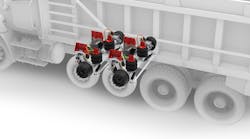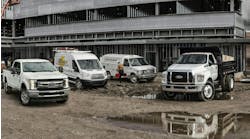The pros, cons, and laws driving aftermarket system or component specification decisions for heavy duty commercial vehicle axle configurations are many and varied. Maybe it’s a quest for bigger payloads that bring with them increased revenue, or maybe it’s the ever-changing patchwork of weight limits and bridge laws throughout the U.S. and Canada. The fact is fleets and owner-operators are driven to retrofit vehicles with self-steer auxiliary axles for a variety of reasons.
When deployed, traditional non-steerable auxiliary axles can be exposed to significant lateral forces, particularly in tight corners. However, retracting the lift axles can overload the remaining axles and suspension system, causing other problems, including compliance issues.
Steerable lift axles help alleviate the potential damage to chassis components, wheels, and tires that can be caused by scrubbing – or dragging – the tires of non-steerable auxiliary axles around corners. The wheels on self-steer auxiliary axles can swivel, allowing them to caster steer themselves by following the path of least resistance. Because they can remain deployed and load bearing while their wheels articulate, steerable lift axles enable a vehicle to maintain proper load distribution and remain in compliance.
“New York’s Divisible Load Notice (DLN#14-01) requires steerable lift axles be retrofit on all vehicles operating under the state’s divisible load permits, including 2005 models and older,” says Frank Dorry, parts manager at New Jersey-based Brown Truck Group, a Mack, Volvo, and International truck dealer. “Customers of ours doing interstate business with our neighboring state had no choice but to comply by January 1, 2020.”
Dorry observes there are three main reasons his customers’ vehicles don’t have steerable lift axles to begin with.
“They didn’t spec them originally because the longer build time was prohibitive, the vehicle application changed in such a way as to require the upgrade, or they bought a used vehicle without them,” he says.
Current challenges
Once the decision is made to retrofit a vehicle with self-steer auxiliary lift axles, fleets must rely on dealers, truck body builders, and upfitters to supply the components. That delivery can sometimes take weeks.
“Telling my customers that they have to wait three to four weeks just for their axles to arrive is no fun,” says Andy Olivera, owner of First Fleet Truck Sales of Lake Worth, Florida. “Particularly now, as the pandemic continues to impact business, my customers want to respond quickly to changing conditions, and standing around waiting just isn’t part of their plan, or ours.”
First Fleet is a custom upfitter that specializes in grapple trucks.
Olivera said that recent factory shutdowns have also negatively impacted the auxiliary axle supply chain, making a bad situation even worse. He advised that losing any business due to a lack of availability right now would be “disappointing, to put it mildly.”
Timing doesn’t just impact the delivery of auxiliary lift axles; it can also impede their installation after arrival. The installation time for a set of axles can commonly take as long as 10 to 12 hours.
“Traditional auxiliary lift axles come as a single unit, with their mounting brackets welded in position,” says Ken Zaychuk, general manager of Horizon Truck & Body of Lethbridge, Alberta, Canada. “Once you maneuver the axle into position, you’re forced to work around components like the hub and drum when drilling the holes in the frame rails.”
Zaychuk described the average retrofit as, “laborious at best and infuriating at worst.” He notes that getting the axle alignment exactly right can be a true challenge, even under the best of circumstances.
Retrofit solutions
To help ease this burden, component manufacturer Link Manufacturing has worked to make the process of obtaining and installing auxiliary steer axles faster. Rather than having to wait weeks for the kits to arrive, units are kept in stock so the fleet can have them within days.
Additionally, the kits are designed to be easier to install so fleets can get each truck retrofitted more efficiently, helping to minimizing downtime. Link Manufacturing’s auxiliary steer axle kit uses technologies the company calls Swift Mount and Swift Alignment. Swift Mount’s interchangeable ride height brackets incorporate improvements in the way the frame brackets attach to the suspension hanger.
“Swift Mount Alignment design uses a stepped-edge on the frame bracket that gives our installers a visual frame of reference, enabling them to quickly align the suspension on the truck,” Brown Truck Group’s Dorry says. “All my guys have to do is compare the frame bracket-to-hanger location for both the driver and passenger sides and it’s centered.”
Faster and more seamless installation processes such as Link’s can be completed in as little as six hours, about half the time of traditional installations.
While steerable auxiliary axle retrofits have inherently been a somewhat slow and painful process, component manufacturers are working to make the process faster and easier for fleets.




